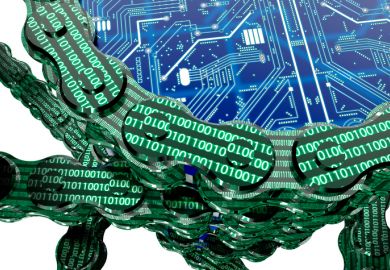Blockchain technology has become synonymous with hype – exhibit A is Bitcoin, a digital currency that uses blockchain, and whose valuation has, in recent months, been pushed wildly up and down by waves of speculator exuberance and panic.
But the technology, which promises to use a decentralised system of online records to do away with the need for central authorities – such as banks – to keep track of who owns or has done what, could still shake up the often slow-to-change world of scholarly publishing, a conference has heard.
Joris Van Rossum, the author of a recent report for the consultancy Digital Science on the potential for blockchain in research, said he realised that it was “slightly overhyped”.
“When I started on blockchain, I also had my doubts,” he said. But since then, he has come around to the view that the technology will have a “profound impact on the way we work”, Dr Van Rossum told the Academic Publishing in Europe conference in Berlin on 17 January.
One of the key promises is that it could help to create a unified, transparent database that tracks every stage of the scientific process, making it harder to falsify data and easier to replicate results.
Currently, researchers themselves, publishers and organisations that track the impact of articles through citations and sharing all use software and tools that are separate, Dr Van Rossum argued: a scientist might write an article in Word, a publisher would edit it using specialist editing software, then citation data would be collected in Web of Science.
The process was fractured because, for a single system to exist, there needed to be a single curator or institution to manage it. “Who would we trust as a community to play that role? It’s very hard,” he said.
“But with blockchain, you could have this database without a single curator,” Dr Van Rossum explained, creating a “single repository of scientific events” with “enormous advantages”.
Sönke Bartling, founder of the Berlin-based thinktank Blockchain for Science, said that putting scientific data as it was produced on the blockchain for all to see with a “timestamp” would make it “much harder to fake the dataset”.
Instead of a final, single sheet of data released at the end of the research process, researchers would leave a “data trail” on the blockchain as they conducted their work, making everything that much more transparent. “This is much harder to change or manipulate than a final dataset,” he said.
But not everyone is convinced. Jason Hoyt, chief executive of the publisher PeerJ, said on Twitter that he thought the idea was a “solution looking for a problem” and was “not convinced” that “lack of trust is there or is significant enough to invest”.
Dr Bartling acknowledged that blockchain solves problems of trust in the scientific process only up to a point – the system still needs someone to confirm things such as how an experiment had been conducted, or who the main author was. “We don’t get rid of trust in third parties, we have a lot of new third parties [in the process],” he said.
As the chair of the debate, Eefke Smit, standards and technology director at the International Association of Scientific, Technical and Medical Publishers, put it: “Garbage in is still garbage out.”
Register to continue
Why register?
- Registration is free and only takes a moment
- Once registered, you can read 3 articles a month
- Sign up for our newsletter
Subscribe
Or subscribe for unlimited access to:
- Unlimited access to news, views, insights & reviews
- Digital editions
- Digital access to THE’s university and college rankings analysis
Already registered or a current subscriber?







